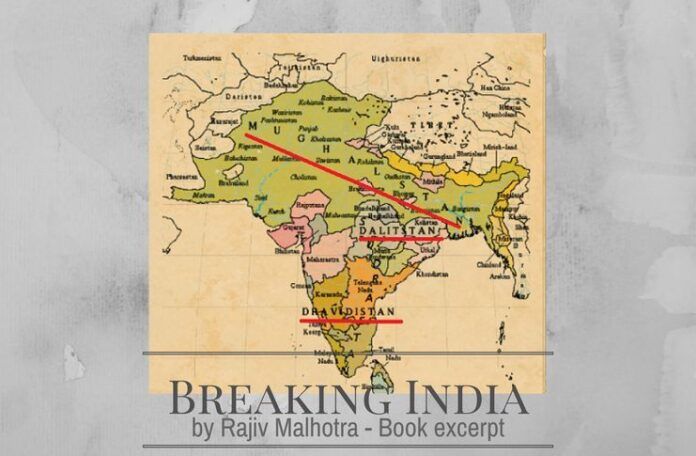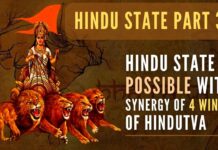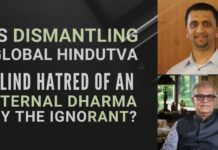
This article is an excerpt (Pages 1 to 7) from the book Breaking India by Rajiv Malhotra & Aravindan Neelakandan. Published by Amaryllis. Delhi. 2011. Link: www.BreakingIndiabook.com
[dropcap color=”#008040″ boxed=”yes” boxed_radius=”8px” class=”” id=””]C[/dropcap]ivilizations provide a shared identity, collective sense of history and shared destiny. It gives a definitive sense of who ‘we’ are, and ensures a deep psychological bond among ourselves, a feeling that the nation is worth defending. Without this bond, who is ‘we’ to defend and what are sacrifices for?
Due to this, breaking a civilization is like breaking a person’s spine. A broken civilization splinters, the balkanized region can metamorphose into rogue states, transforming an entire region into a cataclysm of gigantic proportions.
It’s not just Pakistan provoking disruptive forces in India, or China linking up with Indian Maoists, or evangelical churches or Europe and North America fostering separatism. It is all these and more.
Is Indian civilization vulnerable to such a rupture? What forces, if any, are attempting this? Are they both external and internal? What’s their origin? How do they evolve? How are they managed? The book, Breaking India, by Rajiv Malhotra and Aravindan Neelakandan, addresses these questions, with specific reference to Dravidian and Dalit identities and West’s role in exploiting them.
Much is written about India’s centripetal forces, economic growth, corporate and infrastructure development, and improved national democratic governance, which brings nation together. There are less discussed, seldom studied centrifugal forces, both internal and external. The internal ones include communalism and various socio-economic disparities.
The external forces that bring divisiveness among Indians are complex with links to India’s internal cleavages. This shows various global nexuses; with their own agendas now controlling these internal forces to an unprecedented degree. Yet, Breaking India is not screaming a doomsday scenario, but, an original analysis of the danger our nation is facing.
It’s not just Pakistan provoking disruptive forces in India, or China linking up with Indian Maoists, or evangelical churches or Europe and North America fostering separatism. It is all these and more. These centrifugal forces are deep, subtle, complexly interlinked, and operate as loosely coupled multinational networks.
The nexus Breaking India uncovers might seem far removed from visions of violence and chaos conjured up by notions of ‘secessionism’, ‘insurgency’, and ‘rebellion’. Yet, it establishes that certain academic centers of the West control, or at least heavily influence, the socio-political discourse on India, coupled with political think-tanks, Church activism, and social organizations that feed the centrifugal forces in India, inventing new fault lines and nurturing existing ones. Surprisingly, there is very little counter-discourse on side of India’s unity.
India’ Built-in Tendencies to Fragment
[dropcap color=”#008040″ boxed=”yes” boxed_radius=”8px” class=”” id=””]T[/dropcap]hough it’s tempting to blame outside forces, one must consider India’s weaknesses and old tendencies to fragment. A successful vibrant economy is overshadowing these issues. Some hard realities are:
- India has the largest number of poor citizens in the world, children without schooling, ever increasing water shortage and inter-group conflicts.
- Prevalent social Injustices that are partly historical and modern. Some with internal origins, while others by foreign influences to gain leverage in India.
- Economic success has not reached the lowest strata. Millions enjoy technical education based careers, but a larger number lack even basic education. Middle class, aspiring to Americanize, boasts of automobile infrastructure, yet investments in farming and water infrastructure are dismal and public health is atrocious.
- Separatists threaten everyday life in Kashmir, parts of northeast and states are afflicted with Maoist terrorism. There are incidents of sporadic Islamist terror-attacks and Hindu-Muslim violence. Separatist movements by Dravidians and Dalits create violence across South.
- Cyberspace has become India’s vulnerability. A cyber espionage study terms India as ‘most victimized state’, whose sensitive defense networks and embassy communications are compromised by Chinese espionage and they can pass this vital information to Maoist insurgency. India is bleeding due to these foreign interventions and Maoist terrorism.
- India is surrounded by unstable and radical nations, including failed states; Cross-border violence is being exported into India, tying up economic and military resources. Indian democracy has multiple political parties fragmenting vote banks. India seems to have too much democracy and too little governance. In such a situation, India’s resilience is rather remarkable:
- While US is militarized, with a fortress mindset, to protect its homeland against terrorism, India is not militarized to that extent.
- India has second-largest Muslim population in the world, majority of Muslims remain well-grounded in local, native cultures, and are integrated into Indian society with their Hindu neighbors. Insofar as it has resisted attempts to be co-opted into international pan-Islamist programs, Indian Islam offers an inspiring model for Muslims worldwide in to cultural syncretism and harmonious co-existence with other religions.
- India’s resilience is its strength of accommodation, flexibility and hard policy choices. India’s affirmative action – reservations, implemented over a period of sixty years, has brought remarkable advancements to improvised Dalits (former ‘untouchables’) and disadvantaged groups. But seems inadequate due to the scope of problem. Indian NGOs have provided some assistance.
Cyberspace has become India’s vulnerability. A cyber espionage study terms India as ‘most victimized state’, whose sensitive defense networks and embassy communications are compromised by Chinese espionage and they can pass this vital information to Maoist insurgency.
External Forces
[dropcap color=”#008040″ boxed=”yes” boxed_radius=”8px” class=”” id=””]J[/dropcap]udging India based on benefits provided for its least-privileged citizens, it deserves harsh criticism. A nation-sate that undermines its external capacity to deal with other forces could face invasions, re-colonization, cultural and psychological imperialism, and unwanted interventions. This has happened before! British have used human-rights cases as pretexts to act against Indian rulers.
Ironically, British committed horrible acts, justifying them based on atrocity literature to depict savagery of Indians and claimed that their acts would bring civilization for Indians.
- The Criminal Tribes Act, 1871, legalized genocide of Indian tribes deemed as ‘criminal’ not because they were ‘criminal’, but because they fought British against destruction of their jungles and habitats. The Thugs, a group so maligned via atrocity literature that their name entered English language as being synonymous with criminals.
- Atrocity literature led to downgrading women’s rights. Veena Oldenburg’s seminal book Dowry Murder details British encouraging Indians to share atrocity cases and who later on blamed the native culture, complied anecdotes, mostly unsubstantiated, often exaggerated and one-sided. This book shows how dowry extortions began in Indian middle-class when women’s traditional rights were taken away by the British.
- Nicholas Dirks showed how British using atrocity literature exacerbated conflicts between jatis to solve their problem by intervening, thereby helping them to gain power and extort Indian wealth.
- Atrocity claims against workers were used to outlaw Indian industries, including textiles and steelmaking, in which India was leading over Britain. Meanwhile, British started Industrial Revolution to supply these goods to India as captive market, turning Indians from world-class producers and exporters into importers and paupers. British author William Digby (1757-1812) states that Britain’s profit from India was estimated between 500 million pounds and 1 billion pounds, in today’s value of over a trillion dollars. Economist Amiya Bagchi establishes that British drained India equivalent to five-six percent of current GDP (1984). British alleged atrocity cases against workers, by Indian manufacturers, their competitors, thereby outlawing Indian industries based on workers’ rights violation. The massive poverty and unemployment that resulted made the workers’ plight worse.
Nicholas Dirks showed how British using atrocity literature exacerbated conflicts between jatis to solve their problem by intervening, thereby helping them to gain power and extort Indian wealth.
Hind Swaraj a century old Gandhi’s monograph discusses how Indians unwittingly working for the British Empire to help sustain it. Indians considered themselves patriotic and unaware of the larger picture and British aims they were serving. After hundred years of Gandhi’s diagnosis of colonized Indians, we must introspect:
- Whether West is even more sophisticated in nurturing and deploying Indian sepoys than its British predecessor. It co-opts Indian intellectuals at various levels, from lowly data-gatherers, to identity-engineering programs in murky backwaters of NGOs, to mid-level scholars in India, all the way to Indian Ivy League professors and award-winning globetrotters.
- What the civic society’s and government’s relationship is to Western churches.
- In what ways private foundations – Ford Foundation, Carnegie Foundation, Rockefeller Foundation, to name a few-serve the US government and billionaires to collaborate on fulfilling what many Americans have seen as their manifest destiny.
Breaking India shows that Indian centrifugal forces have not only uplinked with international influences, but have strategically interlinked among themselves for greater synergy.
Breaking India shows that Indian centrifugal forces have not only uplinked with international influences, but have strategically interlinked among themselves for greater synergy. What, then, should be the proper definition of a ‘minority’ when such a group now functions as part and parcel of a global majority? Specifically, Breaking India exposes the formation of Dravidian and Dalit identities over nearly two hundred years, and the role played by Western nexuses.
Overview of European Invention of Races
Western Academic Constructions Lead to Violence
[dropcap color=”#008040″ boxed=”yes” boxed_radius=”8px” class=”” id=””]I[/dropcap]n the past five centuries, European nations colonized regions of Asia, Africa, and Americas. These Western powers imposed a Eurocentric worldview on colonized cultures. Local cultures’ history, including global historic narrative, was constructed to justify colonization. Though biases are exposed, they still wield power in academic and socio-political discourses.
Europe
In eighteenth century, with traditional religious edifice of Europe threatened by Enlightenment, Europeans looked for a golden past, and hoped to find it in India, a source of much of Europe’s import for centuries. In their search, hypothesized and constructed an idealized ‘Aryan race’ through distorted reading of Indian scriptures. Fed by virulent German nationalism, anti-Semitism, and Race Science, this manipulation led to rise of Nazism and Holocaust.
India
In late eighteenth century, Indologist Max Muller proposed Aryan category as a linguistic group, which got transformed into Aryan race by colonial administrators who used Race Science to taxonomically divide traditional Indian communities. Castes designated as ‘non-Aryan’ were marginalized in depictions of Hindu society. In parallel, Church evangelists working in South India constructed a Dravidian race identity, de-linking Tamil culture from its pan-Indian cultural matrix, and claimed that its spirituality was closer to Christianity than to the Aryan North Indian culture.
Sri Lanka
In Sri Lanka, Buddhist revival spurred by Theosophical Society also spread ideas of Aryan race theory. Bishop Robert Caldwell and Max Muller categorized Tamils as Dravidians and Sinhalese as Aryans. This division was encouraged by colonial administrators. Gradually, south Indians adopted this division, turned it into antagonism towards so called Aryans. The result was a deadly ethnic civil war that continued in Sri Lanka for a few decades.
Africa
The Hamitic myth of Bible, where descendents of Noah’s son Ham were cursed, was used by slave traders and slave owners to justify slavery. Hamitic linguistic groups were identified and separated from rest of Africans. African civilization’s contributions were explained as work of an imaginary sub-race of Whites invading and civilizing Africa. Western classification of traditional African communities into races led to bitter rivalries, including genocide, as in Rwanda.
This article is taken from the book Breaking India by Rajiv Malhotra & Aravindan Neelakandan. Published by Amaryllis. Delhi. 2011.
Link: www.BreakingIndiabook.com
Copyright © Infinity Foundation
Join Rajiv Malhotra for his FB LIVE Broadcasts
Follow Rajiv on facebook.com/RajivMalhotra. Official Facebook page.
- Part 2: Discussion between Dr. Swamy and Rajiv Malhotra - September 10, 2017
- Dr Subramanian Swamy In Conversation with Rajiv Malhotra - July 24, 2017
- P2 – Discussing the Digestion of Yoga with a White Hindu - July 3, 2017










